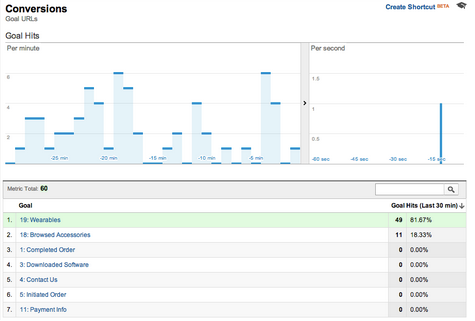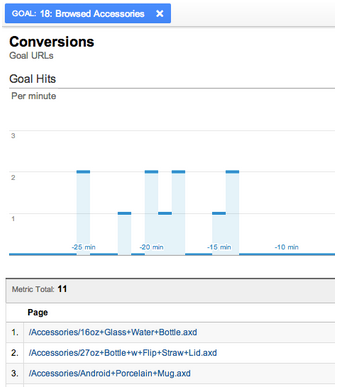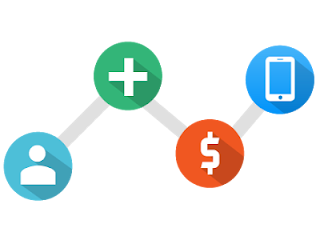
Friday, 31 May 2013

Wednesday, 29 May 2013
Setting up tracking and reporting on your marketing campaigns is simple and fun. This guide will walk you through the process and demonstrate with a real-life example.
Part A: Set up UTM tracking code
- Campaign -name of your overarching campaign - e.g. spring-2013-collection or summer-2013-announcements. Be sure to follow a consistent campaign naming structure.
- Medium - the medium used to send your campaign. Include “email” for an email campaign, “cpc” for ads, “social” for a social network or “landing-page” if you’re tracking button clicks from a landing page.
- Source - used to differentiate the type of medium. If medium = cpc, then source may be google, bing, or yahoo. If utm medium = email, source can be used to call out the action (try, buy, coupon, awareness, etc).
- Content - this is essentially a bonus field - it can be used to track many differentiating factors for your campaign. For example, you can use this field to track different versions of your email or landing page - e.g. “60-dollars-off” or “15-percent-off”.
Part B: Testing reporting
- Recommended best practice is to try each link multiple times, dropping off at various points to ensure you can track a funnel flow.



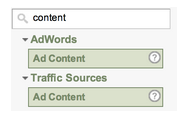

Part C: Advanced Reporting
- Click on “Advanced Segments” at the top of your GA window.

- Click the button “+new custom segment”
- Using “and” or “or” statements, define the segment of your campaign you want to see GA data for:

- Save the segment. You can now browse through your Analytics reports, viewing data only for this segment
Tuesday, 28 May 2013
- Attribution modelling
- Multi-screen measurement
- Driving action with dashboards
- Leveraging online and offline data
- YouTube Analytics
Thursday, 23 May 2013

Next Thursday, join Sara Jablon Moked, Product Marketing Manager for Google Analytics, for a detailed look at effective measurement for today's multi-device world. We will discuss strategies and best practices for measuring customer behavior, and we’ll look at how Google Analytics and other Google tools can help you measure and respond to the evolving customer journey.
The webinar will include live Q&A.
Date: Thursday, May 30, 2013
Time: 10am PST / 1pm EST/ 6PM GMT
Duration: 1 hr
Level: 100 / Beginner
Register: Register here
Posted by the Google Analytics team
Wednesday, 22 May 2013
Today, we’re announcing several updates to Goals in Google Analytics—including a new set-up flow, new templates, and new verification capabilities—to make it easier for you to measure customer behavior and evaluate your performance. These updates are now live in Google Analytics.*
How to get started with Goals
Goals are set at the profile level. To find a profile in your Google Analytics account, click the Admin tab, then navigate to the account, property, and profile you want. Click Goals, then Create a Goal. Follow the flow to set up and start measuring your Goals. For guidance as you set up Goals, visit our help center.
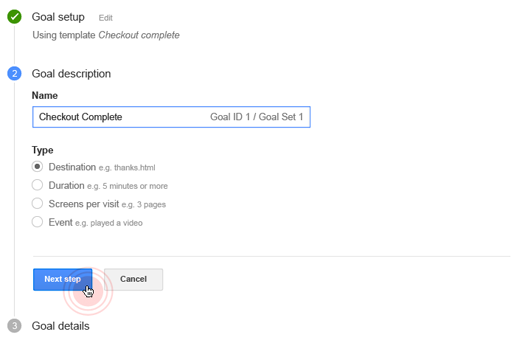
Introducing templates: An easier way to set up Goals
We’ve redesigned and added new templates to the Goals set-up flow so you can add meaningful and actionable Goals to your Analytics account quickly.
When you use a template, the Goal setup flow is prefilled with suggested values (based on your industry) that you can either keep or change as you walk through the process. The templates are organized into four business objectives (Revenue, Acquisition, Inquiry, Engagement) to help you think about the purpose of each Goal, plus you can still create custom goals. Note that “revenue” goals don’t necessarily imply a direct sale -- these goals are user activities which have a strong impact on your desired business outcomes. Depending on your business model, a Revenue Goal could be a purchase, such as a completed checkout; or it could also be a successful lead submission, such as a scheduled appointment. Some Revenue Goals might lend themselves to Ecommerce tracking as well.
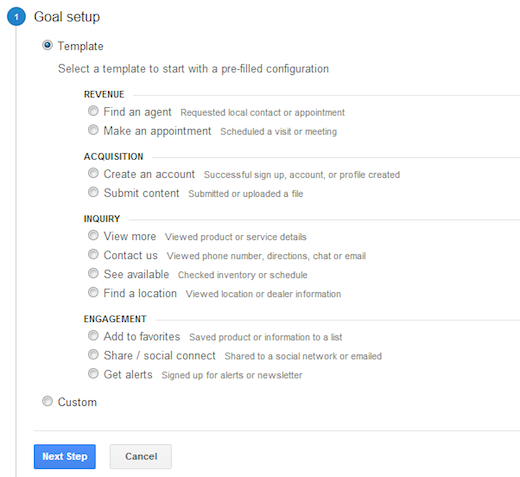
The templates you see are based on the Industry Category selected in your property settings, so you only see templates that are relevant to your business. We also added a set of 20 new industry categories to Google Analytics. This classification is now aligned with Google’s web standard for industry vertical classification. Please edit your property settings to make sure you’re using the one that best describes your business.
Verify each Goal before you save
In addition to the templates, we’ve added a way for you to check your setup before you save. You’ll find a verify option at the end of the setup flow that lets you see what the conversion rate would have been for the past seven days had this Goal been setup. Using the verify option gives you immediate feedback, so you can decide to save or modify the Goal configuration you’re working on.

Analyze how different Goals perform and relate to each other
Use the Goals Overview report under the Conversions section to see how your goal completions happen over time. Develop a sense how often a Goal conversion happens, and look to identify relationships between different Goals.
In the Goals Overview report you can use the metric selector to choose the relevant metric.
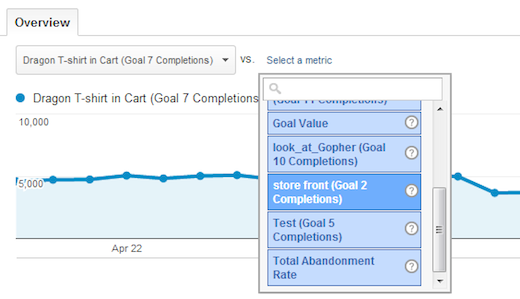
Example: Goal performance over time
Select a single Goal and observe the performance over time. Use the date range selector and compare the Goal performance month on month, or quarter on quarter. This way you can compare seasonal trends, and the growth rate of your goal over time.
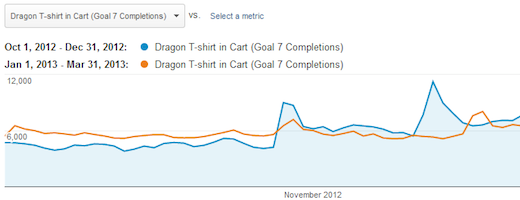
Example: Discover relationships between goals
Selecting two Goal completion metrics next to each other will allow you to see correlational effects over time. A Goal measuring site engagement, like a media interaction, or a social share, could be indicative of a rise in sales.
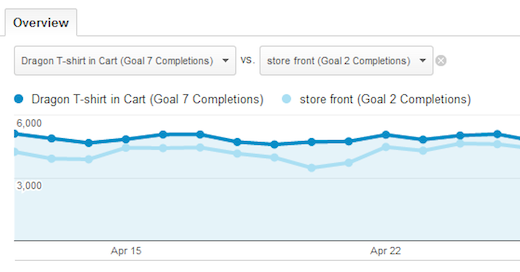
*If you haven't seen this feature yet, don't worry! It's rolling out over the next few weeks.
Posted by Stefan F. Schnabl, Product Manager, Google Analytics
Tuesday, 21 May 2013
- How do creatives leverage, but not be overwhelmed by, technology to deliver next-generation consumer experiences?
- What unique experiences are publishers developing that add value to consumers and advertisers alike?
- How do CMOs best use social with other marketing channels to build strong brands?

9:00 - 9:30 am | Connecting Digital, Accelerating Growth |
9:30 - 10:00 am | The Coca-Cola Company's Liquid & Linked Marketing: How a 127-year-old company is pivoting for success in a real-time, socially-connected world The Coca-Cola Company sells over 500 brands in 207 countries, with over 700,000 System associates and 1.8B+ servings of their beverages everyday. Hear insights and lessons learned on how the world's most valuable brand is remaining relevant by becoming more connected, transparent and nimble in real-time. |
10:00 - 10:35 am | Advertisers Must be Inventors This year, Volkswagen and Deutsch LA partnered with Google to work on a briefto re-imagine how to build a stronger, bigger community around its brand. In today’s connected world, telling stories alone isn’t enough; we need to create tangible value and utility to bring the brand’s promise to life. In this session the creative team from Deutsch LA will be talking about the process for developing more rewarding and shareable experience. |
10:35 - 11:15 am | Time to Rethink the Marketing Mix? Emerging trends in digital marketing -- including new ad formats, the rise of social media, and proliferation of channels -- are creating new challenges and opportunities for brand marketers. What are the key trends marketers should be concerned about -- and how should they respond? AdAge deputy editor Michael Learmonth poses the hard questions in an executive dialogue on what’s next for brand marketing. Fireside chat with: |
11:15 am - 12: 15 pm | New and Native: Extending the Conversation Technology has had a profound impact on the media industry. This disruption, though, has brought along significant opportunities for creative publishers to thrive. In this session we’re bringing in three executives to show how they’ve leveraged the digital revolution to deliver more engaging content and differentiated solutions to advertisers. |
Monday, 20 May 2013
It was a busy week in San Francisco at Google I/O. We unveiled new products and features, such as deeper mobile app analytics integration with Google Play and Google Tag Manager for mobile apps. If you missed the earlier announcement, you can learn about our new features here.
We also gave several great presentations on some of our new features. Our Developer Relations team also showed off some tools for multi-screen measurement here, so take a look if you didn’t manage to catch our livestream this past Thursday.
We also presented on dynamically configuring mobile applications using Google Tag Manager for mobile apps, and talked about Google Analytics and AdSense data analysis in BigQuery.
It was great to see so many GA users and developers-- we can’t wait to see everyone next year at I/O!
Posted by Aditi Rajaram, Google Analytics team
Thursday, 16 May 2013
- Leverage Google’s massive computing power to get business insights from big data in seconds rather than hours.
- Analyze massive amounts of data in the cloud with no up-front investments (hardware provisioning or software licensing investments).
- Share and collaborate quickly and securely using Access Control Lists.
- Store as much as you want, paying only for what you use.
- Protect your data with multiple layers of security from Google.
- Analyzing visitor behavior across very large date ranges. Answer the question: "From 2010 to 2013, which sections of my site had the most volatility in daily traffic volumes?"
- Joining against data from other sources. Make detailed, custom analyses, such as: "I have a database that contains all the metadata about each article posted on my site and would like to see the bounce rate, conversion rate and new visitors generated by author and topic."
- Understanding complex queries. Answer the question: "Of the visitors to my site that used a voucher code, how many originally discovered my brand from a voucher code site and how many left the checkout process and returned within 10 minutes with a voucher code? Which codes were used in each case?"
- Integrating with Data Warehouses. Make detailed, custom analyses, such as: "On a weekly basis, for each of my logged in customers, I want to see the top 5 products that they viewed but did not buy and add that information into their record in our CRM."

Tuesday, 14 May 2013
We’ve been working hard getting ready for Google I/O! We're livestreaming our presentation on how to optimize web and mobile apps across devices using Google Analytics on Thursday, May 16 at 1:40pm PT and we’d like to invite everyone to join us.
We recently launched Universal Analytics, a new way to measure user interactions across any device / platform / environment. By measuring this data, developers can better optimize their applications. In this session we'll discuss how to measure user-interaction from any device as well as demo new reports and best practices to optimize both web and mobile apps.
For those of you who are going to be at I/O, please stop by the Ads sandbox and say hi to the Analytics team! We’ll be around to answer questions, and we may even have some pretty cool Analytics gear to give out. Be sure to check out all of our Analytics sessions. You can find the full schedule here.
Posted by Aditi Rajaram, Google Analytics team
Thursday, 9 May 2013
- Is a mobile device
- Is a tablet
- Mobile brand name
- Mobile model name
- Mobile marketing name
- Mobile pointing method
- Mobile has QWERTY keyboard?
- Mobile is NFC supported?
- Mobile has cellular radio?
- Mobile has wifi?
- Social network
- Social action
- Social action target
- Hit type: (page, social, transaction, etc.)
- Internal search term
- Internal search type
- Browser size
- IP version
- Local currency code
Monday, 6 May 2013

Thursday, 2 May 2013
